
Edgar Cayce also told in his readings about "huge beasts" and "giant lizards", which lived in the earlier times of Atlantis. He mentioned that the first ape-like human beings, which were living in caves, existed as early as 10,500,000 BC (Cayce reading 2665-2). In the times of Atlantis, around 50,000 BC, enormous carnivorous beasts were threatening man in many parts of the world. Mankind did built gigantic architecture to partially keep the large animals from entering a city and partially for earthquake stability. At a later time there had been a gathering of people from five nations around the world, where the decision had been made to exterminate these beasts, because otherwise people may had not been able to survive (reading 262-39).
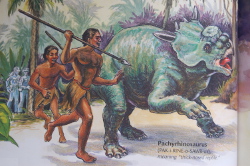
First poisonous gasses were used in the caves where they dwelled, but this wasn't a huge success; Because of sudden wind changes these gasses came back to the people and it often only made the beast come out enraged. They ultimately coped with them with explosives and by "sending out super-cosmic rays from various central plants". In 1932 he said: "These rays will be discovered within the next twenty-five years." This could have been referred to the later (re-)discovery of the anti-neutron beam.
There
was another ray which created a radiating force by storing up energy
in a small insulating crystal of special magnetic properties, so that
the crystal passes on more energy that it receives. This sound very
much like the laser, which also wasn't discovered until the
sixties.
Huge
and numerous gas pockets were blown open in the lairs of the animals
which precipitated volcanic eruptions and earthquakes in the still
slowly cooling Earth, and caused the first continental catastrophe
which affected both Lemuria and Atlantis; The axis of the world
started to shift, which led to the beginning of the last great ice
age. Lemuria was the first to be affected while Atlantis followed
shortly. After the catastrophe, the huge beasts did became
nearly extinct.
Could
it be that among these giants beasts/lizards there were those giant
reptiles we know today as dinosaurs? And could it be possible that
these animals still have survived up to the early times of Atlantis?
Edgar Cayce is not alone in this claim, as various psychic intuitives
made the mention of large, currently extinct animals, who lived in
the same time frame as mankind. Trance medium Daan Akkerman asserted
in his book: "Atlantis en ufo's (2003)" that most of current modern
scientist erroneously dated the remains
of these animals back to millions of years, it would have
concerned animals that lived "only" 25,000 years
ago.
According
to trance clairvoyant Dr. Douglas James Cottrell, around 23,000 years
ago was the time of the Grand Meeting of all chiefs of the world to
do away with those large beasts (these we might term "prehistoric")
that were deemed destructive and a menace to the Earth. These beasts
were the reason for the construction of certain ancient underground
"cities", wherein these beasts could not enter. He was also
once asked about the demise of the dinosaurs, the answer was:
"Those beasts that ran upon the Earth itself, that were somewhat an inconvenience to those humans who lived upon the Earth at the time. There would be, first: the climatic changes that would be similar to this, but as such there would be the shift at the planets' rotation, and as such, those that would be existing in humid climates - as most of these beasts did - they would have been shifted or put into very cold climates, and this would have caused their demise, but primarly it would be large masses of water sweeping across the continent itself. Evidence of this would be the caches of bones found along hills or mountain ranges or ridges, in which their carcasses would have been swept and deposited as you would say. When you find them in large groupings, these are not pawns that they have fallen into, it is that their bodies had been swept across the mass of land as large waves have come across the landmass, and they would have drowned, you would say."
(Source: Rev. Douglas James Cottrell DTM Session: Ezekiel's wheel, the Garden of Eden, and the Dinosaurs' demise, by Rammsteinregeln.)
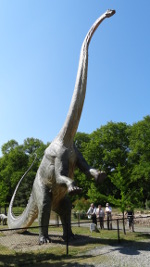 Current
modern science assumed for a long time that all dinosaur species
abruptly became fully
extinct some 65 million years ago, possibly because of a huge
catastrophe, and therefore there would never had been a time when
dinosaur and man lived together. This time period of 65 million years
was based on the fact that no remains were found
that dated back to earlier times. However, could it be possible
these datings were, for whatever reason, more or less off the hook?
Current
modern science assumed for a long time that all dinosaur species
abruptly became fully
extinct some 65 million years ago, possibly because of a huge
catastrophe, and therefore there would never had been a time when
dinosaur and man lived together. This time period of 65 million years
was based on the fact that no remains were found
that dated back to earlier times. However, could it be possible
these datings were, for whatever reason, more or less off the hook?
Before the year 2005, only fossilized
bones were dated. Fossilized bones are bones that are turned into
stone, and stone as a
material itself cannot be directly dated by any currently known dating
technique, so they looked at the earth layer in which the remains had
been found. But the Earth was quite active in the past, and because of tectonic activity,
dramatic climate changes, the possibility and consideration of pole
shifts and floods, one could not always say that: "the deeper the
fossilized bones of a dinosaur where found, the older it has to be".
Long it has been assumed that petrification takes millions of years, but as explained in the previous chapter: "Technological Advancements", since the year 2005 it had been discovered that, under special conditions, it is possible for petrification to happen in only a few days. Today's scientists could be wrong in their findings that these animals became fully extinct millions of years ago, as there could be the possibility that at least some species may have survived much longer.
Also
in 2005, there had been made a very important discovery about the
dinosaurs; Paleontologist Dr. Mary Schweitzer and her group discovered
the first remains of blood cells in dinosaur fossils and later
also discovered soft tissue remains in the Tyrannosaurus Rex
specimen MOR
1125.
At first this seemed undeniable evidence that these dinosaurs
couldn't be million years old. Under the assumption that this could not
be possible, a theory was put forward that
suggested that, under optimal preservation
circumstances, this
material could still have been preserved. However, it is highly
unlikely that soft tissue could still remain after millions of years.
Another discovery had been made by physicist Dr. Thomas Seiler. During the year 2012, he presented the findings of his team about their Carbon 14 (C-14) dating of multiple samples of bone from eight dinosaurs from Texas, Alaska, Colorado and Montana. He revealed that these samples were dated to only 22,000 to 39,000 years old. After their AOGS-AGU conference in Singapore, the abstract was removed from the conference website by two chairmen because they believed there had to be an error in the data.
Furthermore, in May 2012 a Triceratops brow horn was excavated by palaeontologist Otis Kline Jr., microscope scientist Mark Armitage and microbiologist and avocational palaeontologist Kevin Anderson in Dawson County, Montana. Microscopic examination revealed that it contained not only fossilized bone but also preserved layers of soft tissue. Like Dr. Mary Schweitzer's discovery, the finding of preserved tissue would imply that the bone most likely couldn't be million years old. Two bone samples (GDFM 12.001a and GDFM 12.001b) were sent to the University of Georgia, Center for Applied Isotope Studies for Carbon-14 dating, and yielded an estimated date of 33,570 ± 120 years for the first sample and 41,010 ± 220 years for the second. In February 2013, he published his findings in "Acta Histochemica", a praised journal of cell and tissue research (M. H. Armitage and K. L. Anderson, 115, 603–608; 2013). However, two weeks later he was fired from his job at California State University, Northridge (CSUN), accused of pushing his ideas as a creationist in the journal. He didn't leave it at that and sued the university in July.
From this evidence it would appear that man and dinosaur once indeed did co-exist. Could we regard certain myths, legends and folklore as clues that remembrances of dinosaurs still existed in medieval times? The taxon "dinosauria" was formally named in 1842 by paleontologist Sir Richard Owen, but before these times these fearful beasts were possibly already mentioned in the myths and legends of various old and ancient civilizations as "dragons".
Dragons are mentioned in Norse, Greek and Chinese mythology and in medieval legends such as St. George and the Dragon. According to description and illustrations these were often slender, serpent- or lizard-like creatures, often with four paws and sometimes with wings, and while they were not exceptionally huge proportions, they still were deadly predators. Some medieval depictions of dragons are looking much like the dragons as depicted in Chinese art. (See for example the image on the right from the work "Roman de Brut" by the 14th century poet Wace.) The dragon is also part of the animals from the Chinese zodiac, where the all other animals are known non-mythological creatures, which could suggest that the dragon was also once seen as a creature that once really existed.
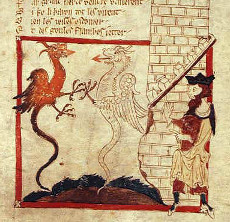 Dragons were
also already mentioned in the Tanakh and both the
Old and the New
Testament of the Bible. The Old-Hebrew word: "Tanniyn" is usually
translated to: dragon, serpent, or sea monster. In modern Hebrew usage
the word Tanin means "crocodile". In
the "Book of Job", there is a list of impressive animals which includes
the enormous "Behemoth" (see Job
40:15-24) and the "Leviathan" (see the
books Job,
Psalm and Isaiah). During medieval times the
Behemoth had been interpret as an elephant until the French
Protestant pastor Samuel Bochart suggested in his "Hierozoicon"
(1663) that it could be a hippopotamus, and remained the most common
interpretation so far.
Dragons were
also already mentioned in the Tanakh and both the
Old and the New
Testament of the Bible. The Old-Hebrew word: "Tanniyn" is usually
translated to: dragon, serpent, or sea monster. In modern Hebrew usage
the word Tanin means "crocodile". In
the "Book of Job", there is a list of impressive animals which includes
the enormous "Behemoth" (see Job
40:15-24) and the "Leviathan" (see the
books Job,
Psalm and Isaiah). During medieval times the
Behemoth had been interpret as an elephant until the French
Protestant pastor Samuel Bochart suggested in his "Hierozoicon"
(1663) that it could be a hippopotamus, and remained the most common
interpretation so far.
The suggestion of a dinosaur has only arisen
in relatively modern times. The scarce description of the Behemoth is
that of a huge grass eating animal, like a sauropod dinosaur like
the Diplodocus.
The Leviathan is described as a powerful serpent-like sea creature
with limbs, which could refer to the Plesiosaur or
the Mosasaur,
both huge prehistoric sea creatures. Interestingly enough,
Daan Akkerman's readings mention that the story in the "Book of
Job" took place during the even older pre-Atlantean times
of Lemuria (900,000 BC to 250,000 BC - according to Edgar
Cayce).
Among the apocrypha, there is the story of "Bel
and the Dragon", where the Babylonian king
Nebuchadnezzar kept a great dragon in the temple of the (false)
diety Bel. This dragon might have looked like the animal which is now
known as the "mushhushshu", which was depicted in ancient
Babylon art for centuries, and also was shown at walls of the "Ishtar
Gate" from ancient Babylon.
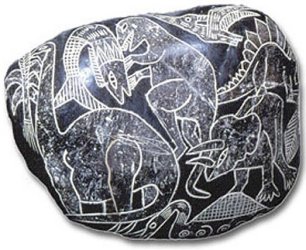
During the 1500s,
Spanish Conquistadors brought back
stories that there were stones with strange creatures carved on them
found in a cave near Ica, Peru. They were believed to be ceremonial
burial stones from the Nazca culture. Some of the stones were even
brought back to Spain. In his work: "Relacion de antique dades
d'este reyno del Peru", Indian chronicler Juan de Santa Cruz
Pachucuti Llamgui already wrote in the year 1571 about these strange
engraved stones from Ica, long before the very first remains of a
dinosaur were recognized in the early 19th century. These stones were
called "Manco" and were found in the "Kingdom of
Chperu" tomb in Chinchayunga.
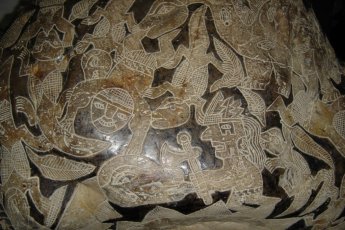 The Ica
stones were
popularized in 1970 by Dr. Javier Cabrera, a Peruvian medical doctor
who received an engraved stone as a birthday gift. In thirty-five
years, he had collected over 11,000 engraved stones. The clearly
illustrated andesite stones are depicting humans, dinosaurs (of the
Jurassic type), even humans riding and fighting with dinosaurs,
advanced technology like telescopes, maps of the Earth (including
what very much looks like the lost continent of Atlantis), ritual and
sexual depictions, and more.
The Ica
stones were
popularized in 1970 by Dr. Javier Cabrera, a Peruvian medical doctor
who received an engraved stone as a birthday gift. In thirty-five
years, he had collected over 11,000 engraved stones. The clearly
illustrated andesite stones are depicting humans, dinosaurs (of the
Jurassic type), even humans riding and fighting with dinosaurs,
advanced technology like telescopes, maps of the Earth (including
what very much looks like the lost continent of Atlantis), ritual and
sexual depictions, and more.
Dr. Javier asserted that he had found most of the stones within a certain cave. He would also have collected many stones from a farmer named Basilio Uschuya, who admitted however that he made these artefacts himself to sell them as souvenirs. Unfortunately, this incident caused much damage to the credibility of these stones.
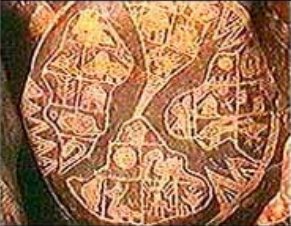
This stone seems to be a very abstract world map showing America (center),
Lemuria (left) and Atlantis (right). The little figures within the square boxes
probably show the kind of animals and vegetation within that area.
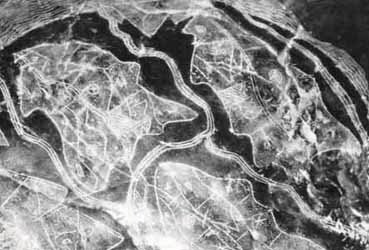
One of the stones seems to be a map of the world,
possibly including the continent of Atlantis (left from the center)
Research has shown that erosion of the images on the stone was minimal, therefore it is believed by many they couldn't be very old. However, the oxidisation in the carvings of one of the Ica stones has been dated to at least 55,000 years old, which places its origins right within the time frame given by Edgar Cayce when dinosaurs still would have roamed on the Earth and co-existed with man. (More information and photo's at: http://nazcamystery.com and http://www.jseaward.co.uk.)
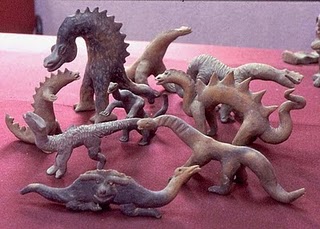 In
1944 in Acámbaro, Mexico, there allegedly had been found
several thousands of small ceramic figurines in the form of
dinosaurs, and humans riding them. (See the image right). They are
generally regarded
as a hoax, because it was rumoured that these kind of figures where
still being made by traditional artists in more recent and modern
times. Although, this does not exclude the possibility that these kind
of figures could be based on true ancient originals. It is often said
that
there is no reliable evidence for the validity of these figures as
actual ancient artefacts.
In
1944 in Acámbaro, Mexico, there allegedly had been found
several thousands of small ceramic figurines in the form of
dinosaurs, and humans riding them. (See the image right). They are
generally regarded
as a hoax, because it was rumoured that these kind of figures where
still being made by traditional artists in more recent and modern
times. Although, this does not exclude the possibility that these kind
of figures could be based on true ancient originals. It is often said
that
there is no reliable evidence for the validity of these figures as
actual ancient artefacts.
In 1955, outcomes of radio-carbon
dating of
these figures in New Jersey showed an age between 1,600 BC and 1,110
CE. More surprisingly, an additional 18 pieces were dated by the
University of Pennsylvania at around 2,500 BC.
(Source: http://mexicanarcheology.tripod.com)
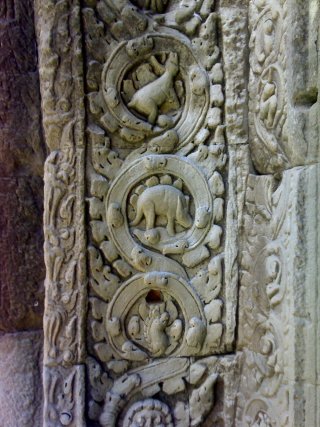 At
the ruins of an ancient Buddhist
temple called Ta Prohm, near Angkor
Wat in Cambodia, there is a certain
stone relief depicting humans, various animals and what seems to be
mythological creatures. Around these animals we can see decorations
that may represent cycles of creation, possible related to the
evolution of these animals. Among these animals, there is one
particular animal which seems to have plates on his back, just like
a stegosaurus.
At
the ruins of an ancient Buddhist
temple called Ta Prohm, near Angkor
Wat in Cambodia, there is a certain
stone relief depicting humans, various animals and what seems to be
mythological creatures. Around these animals we can see decorations
that may represent cycles of creation, possible related to the
evolution of these animals. Among these animals, there is one
particular animal which seems to have plates on his back, just like
a stegosaurus.
However,
the head of the animal is too large for any kind of
stegosaurus that we know of today, as all known species of
Stegosauria actually had a proportionally small head. Some assume
that these plates are part of the surrounding ornaments, but this
does not seem to be the case as the forms of these plates are
actually similar to those of a stegosaurus and do not fully
match the shapes of the ornaments, and also, these kind of plates or
ornaments are missing in the depictions if the animals
above and below the stegosaurus. (Click here
for an enlarged image, and here for a close-up.)
Apart from the plates, the
animal looks somewhat like a rhinoceros instead, especially the
Sumatran rhinoceros because of its short horn. The rhinoceros
however, always has a very thin and short tail, unlike the thick tail
in the pictures above. Because of the large head, the heavy build and
the seemingly absence of a horn, it also shares some characteristics
of the toxodon,
which was a mammal which looked like a rhino without a horn, that
according to archaeology became extinct at the end of the
Pleistocene, which was around 12,000 years ago. But like the
rhinoceros, the toxodon also had a thin and short tail. Whether it
depicts a stegosaurus or not, it seems to depict some kind of
prehistoric, now extinct animal. There
is also another creature above it which looks like another,
two-legged dinosaur.
(See www.genesispark.com for more information about dinosaurs in old literature, art and history.)



